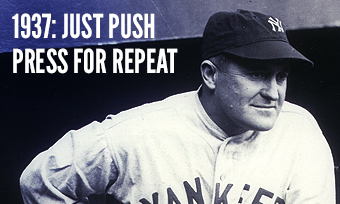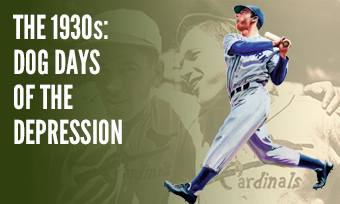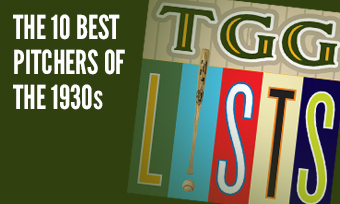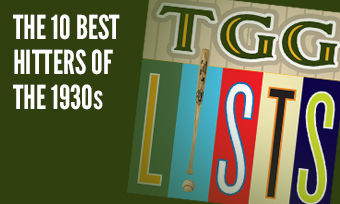The Yearly Reader
Leaders and Honors, 1937
Our list of baseball’s top 10 hitters and pitchers in both the American League and National League for the 1937 baseball season, as well as the awards and honors given to the game’s top achievers of the year.
The National League’s Top 10 Hitters, 1937
Bold type in brick red indicates league leader.
1. Joe Medwick, St. Louis
Key Numbers: 156 games, .374 average, 633 at-bats, 111 runs, 237 hits, 56 doubles, 10 triples, 31 home runs, 154 RBIs, .641 slugging percentage.
Medwick won more than just the NL’s last triple crown to date; only his lack of speed kept him from leading in every major offensive category, falling short in triples and steals. His 56 doubles gave him 120 over just two seasons.
2. Johnny Mize, St. Louis
Key Numbers: .364 average, 103 runs, 204 hits, 40 doubles, 7 triples, 25 home runs, 113 RBIs.
The Big Cat set a career high in batting average, finishing second on the charts to Medwick.
3. Dolph Camilli, Philadelphia
Key Numbers: 131 games, .339 average, 101 runs, 27 home runs, 80 RBIs, 90 walks, .446 on-base percentage.
In his last year at Philadelphia—and the Phillies’ last at Baker Bowl—Camilli was the last slugger to take advantage of the decrepit yard by hitting .369 with 16 homers at home.
4. Frank Demaree, Chicago
Key Numbers: .324 average, 104 runs, 199 hits, 36 doubles, 6 triples, 17 home runs, 115 RBIs, 23 grounded into double plays.
Escaping major injury in a nasty offseason car accident near his Northern California home, Demaree enjoyed a career year—so good, he even scored a run on a triple play.
5. Mel Ott, New York
Key Numbers: .294 average, 99 runs, 28 doubles, 31 home runs, 95 RBIs, 102 walks.
Master Melvin managed to butt in on Joe Medwick’s dominance, tying him for a share of the home run lead; it was the third and last time that Ott finished tied with someone else atop the NL dinger charts.
6. Billy Herman, Chicago
Key Numbers: .335 average, 106 runs, 189 hits, 35 doubles, 11 triples, 8 home runs, 65 RBIs.
Herman failed to record 200 hits for the third straight year, but he did pace the Cubs with 106 runs—one of four players on the team to plate at least 100.
7. Paul Waner, Pittsburgh
Key Numbers: .354 average, 94 runs, 219 hits, 30 doubles, 9 triples, 74 RBIs, 63 walks.
Waner had his fifth 20-game hit streak of his career; he’d make it six in 1939. He also recorded over 200 hits for the eighth (and last) time, surpassing former Pirates legend Honus Wagner.
8. Arky Vaughan, Pittsburgh
Key Numbers: 126 games, .322 average, 17 doubles, 17 triples, 5 home runs, 72 RBIs.
A spate of minor midseason injuries didn’t keep Vaughan from pacing the NL in triples for the second time in his career.
9. Dick Bartell, New York
Key Numbers: 128 games, .306 average, 91 runs, 38 doubles, 14 home runs, 62 RBIs, 10 hit-by-pitches.
Bartell did his best to provide sidebar power for Mel Ott, tying a career high with 14 homers.
10. Stan Hack, Chicago
Key Numbers: .297 average, 106 runs, 173 hits, 27 doubles, 6 triples, 83 walks, 16 stolen bases, 19 caught stealing.
The third baseman remained consistent in hitting around the .300 mark, scoring over 100 runs…and leading the NL in times caught stealing.
The American League’s Top 10 Hitters, 1937
1. Hank Greenberg, Detroit
Key Numbers: .337 average, 137 runs, 200 hits, 49 doubles, 14 triples, 40 home runs, 184 RBIs, 102 walks.
Greenberg said that RBIs were more important to him than home runs, so he must have had an awful lot to be proud of in 1937.
2. Joe DiMaggio, New York
Key Numbers: .346 average, 151 runs, 215 hits, 35 doubles, 15 triples, 46 home runs, 167 RBIs, .673 slugging percentage.
The Yankee Clipper hit over 40 homers for the only time in his career; he claims that it might have been closer to 70 if not for the distant reaches to Yankee Stadium’s left-field bleachers, an area known as “Death Valley.”
3. Lou Gehrig, New York
Key Numbers: 157 games, .351 average, 138 runs, 200 hits, 37 doubles, 9 triples, 37 home runs, 159 RBIs, 127 walks, .473 on-base percentage.
In the last of a long line of spectacular seasons, Gehrig reached 200 hits for the eighth time, knocked in at least 120 runs for the 11th straight time, and led the AL in on-base percentage for the fourth straight year.
4. Charlie Gehringer, Detroit
Key Numbers: .371 average, 133 runs, 209 hits, 40 doubles, 14 home runs, 96 RBIs, 90 walks, 11 stolen bases.
With a career-high batting average at age 34, Gehringer was one of a record four Detroit hitters who banged out 200 hits.
5. Bill Dickey, New York
Key Numbers: .332 average, 176 hits, 35 doubles, 29 home runs, 133 RBIs, 73 walks.
The potent-hitting catcher nearly joined DiMaggio and Gehrig in averaging more than one RBI per game; he did his best to get over that hump in early August, hitting grand slams in back-to-back games.
6. Harlond Clift, St. Louis
Key Numbers: .306 average, 103 runs, 175 hits, 36 doubles, 7 triples, 29 home runs, 118 RBIs, 98 walks.
For the second straight year, Clift ganged up with teammate Beau Bell to knock in 100 runs each for a 100-game loser, the last time any pair would do it even once until 2002.
7. Bob Johnson, Philadelphia
Key Numbers: 138 games, .306 average, 91 runs, 32 doubles, 6 triples, 25 home runs, 108 RBIs, 98 walks.
With Jimmie Foxx having moved on to Boston, Johnson became the undistinctive star with the undistinctive name—but he was still quite effective.
8. Zeke Bonura, Chicago
Key Numbers: 116 games, .345 average, 79 runs, 41 doubles, 19 home runs, 101 RBIs.
A groin injury sidelined Bonura for a month and kept him from inching up this list.
9. Wally Moses, Philadelphia
Key Numbers: .320 average, 113 runs, 208 hits, 48 doubles, 13 triples, 25 home runs, 86 RBIs.
Bob Johnson found some support in the lineup with Moses, who became the last Athletic to collect 200 or more hits until Miguel Tejada in 2002.
10. Gee Walker, Detroit
Key Numbers: .335 average, 105 runs, 213 hits, 42 doubles, 18 home runs, 113 RBIs, 23 stolen bases.
The swift outfielder reached his peak with career highs in home runs and RBIs, starting his season with a bang as he hit for the cycle on Opening Day while hitting safely in his first 27 games.
The National League’s Top 10 Pitchers, 1937
1. Jim Turner, Boston
Key Numbers: 2.38 ERA, 20 wins, 11 losses, 33 appearances, 30 starts, 24 complete games, 5 shutouts, 256.2 innings, 52 walks.
Better late than never; at age 34, Turner was the oldest of three NL rookies winning 20 games on the year.
2. Cliff Melton, New York
Key Numbers: 2.61 ERA, 20 wins, 9 losses, .690 win percentage, 7 saves, 46 appearances, 27 starts.
After wildly flunking a trial with the Yankees, Melton was right on target as a rookie Giant on the NL side of the Harlem.
3. Lou Fette, Boston
Key Numbers: 2.88 ERA, 20 wins, 10 losses, .667 win percentage, 35 appearances, 33 starts, 23 complete games, 5 shutouts, 259 innings.
Like teammate Jim Turner above, Fette got a late start on the major league scene at age 30—and never recaptured that initial glory in the few years to follow.
4. Danny MacFayden, Boston
Key Numbers: 2.93 ERA, 14 wins, 14 losses, 246 innings.
Unlike Jim Turner and Lou Fette, MacFayden failed to get a piece of the 20-win action in Boston thanks to relatively tepid run support.
5. Carl Hubbell, New York
Key Numbers: 3.20 ERA, 22 wins, 8 losses, .733 win percentage, 4 saves, 39 appearances, 32 starts, 261.2 innings, 55 walks, 159 strikeouts.
Hubbell nabbed his fifth and final 20-win effort, all in succession.
6. Van Lingle Mungo, Brooklyn
Key Numbers: 2.91 ERA, 9 wins, 11 losses, 25 appearances, 21 starts, 161 innings, .229 batting average against.
Many remember the 1937 All-Star game as the one Dizzy Dean suffered a career-neutering injury, but it also ended Mungo’s effectiveness as a pitcher, as he was used against the advice of the Dodgers. Shoulder issues became more problematic, he failed to win any of his remaining four starts before being shut down, and won only 27 games over seven more seasons.
7. Dizzy Dean, St. Louis
Key Numbers: 2.69 ERA, 13 wins, 10 losses, 27 appearances, 25 starts, 197.1 innings, 33 walks.
Dizzy was on point through the All-Star Game, where he had his toe broken on an Earl Averill comebacker; he was only 1-3 in seven starts (with a decent 3.59 ERA) after the break, and would never be the same, pre-Averill.
8. Tex Carleton, Chicago
Key Numbers: 3.15 ERA, 16 wins 8 losses, .667 win percentage, 27 starts, 18 complete games, 4 shutouts, 208.1 innings.
Carleton tolerated his most impressive collection of numbers as much as he enjoyed it, dealing with bone chips that would begin to derail his career the next season.
9. Bill Lee, Chicago
Key Numbers: 3.54 ERA, 14 wins, 15 losses, 42 appearances, 34 starts, 17 complete games, 272.1 innings, 31 grounded into double plays.
A productive but frustrating campaign for Lee, whose solid pitching somehow couldn’t get him to the .500 mark on a team that finished 93-61.
10. Russ Bauers, Pittsburgh
Key Numbers: 2.88 ERA, 13 wins, 6 losses, .684 win percentage, 34 appearances, 19 starts, 11 complete games, 187.2 innings.
In a season full of first-year standouts in the NL, the 23-year-old Bauers was clearly the youngest of them all—but long-term success would become elusive.
The American League’s Top 10 Pitchers, 1937
1. Lefty Gomez, New York
Key Numbers: 2.33 ERA, 21 wins, 11 losses, 34 appearances, 34 starts, 25 complete games, 6 shutouts, 278.1 innings, 194 strikeouts.
Gomez won the pitchers’ triple crown—leading the AL in wins, ERA and strikeouts—for the second time in four years.
2. Red Ruffing, New York
Key Numbers: 2.98 ERA, 20 wins, 7 losses, .741 win percentage, 256.1 innings.
The other steady Yankee ace jumped on the mound cold after skipping out on Spring Training due to contract issues, but it hardly impacted his final numbers.
3. Lefty Grove, Boston
Key Numbers: 3.02 ERA, 17 wins, 9 losses, 21 complete games, 262 innings, 153 strikeouts.
Grove hiked up his strikeout totals to the highest point since his heyday with the A’s.
4. Monty Stratton, Chicago
Key Numbers: 2.40 ERA, 15 wins, 5 losses, .750 win percentage, 22 appearances, 21 starts, 164.2 innings, 37 walks.
A year after losing his appendix and tonsils—and a year before losing his leg in a hunting accident—Stratton proved what he could do as a complete, pain-free performer on the mound.
5. Johnny Allen, Cleveland
Key Numbers: 2.55 ERA, 15 wins, 1 loss, .938 win percentage, 24 appearances, 20 starts, 173 innings.
Allen’s near-perfect campaign gave him a career record of 85-30. Greatly helping out: 7.35 runs per start from his mates.
6. Elden Auker, Detroit
Key Numbers: 3.88 ERA, 17 wins, 9 losses, 39 appearances, 32 starts, 19 complete games, 252.2 innings.
With Schoolboy Rowe and Tommy Bridges in decline, Auker became the top dog in the Tigers rotation, pitching submarine style as a result of a shoulder separation suffered as quarterback of the Kansas State football team.
7. Thornton Lee, Chicago
Key Numbers: 3.52 ERA, 12 wins, 10 losses, 204.2 innings.
Had he gotten the kind of support his staff teammate Vern Kennedy received (6.1 runs per start versus his 4.1), Lee certainly would not have won two fewer games (14 to his 12).
8. Jack Wilson, Boston
Key Numbers: 3.70 ERA, 16 wins, 10 losses, 7 saves, 51 appearances, 21 starts, 221.1 innings, 119 walks.
For the only time in his nine-year career, Wilson kept his ERA below the 4.00 mark.
9. Monte Pearson, New York
Key Numbers: 3.17 ERA, 9 wins, 3 losses, 20 starts, 144.2 innings.
The second-year Yankee made the most of an injury-marred campaign, further contributing in the World Series with a near-complete (8.2 innings) victory in Game Three against the Giants.
10. Mel Harder, Cleveland
Key Numbers: 4.28 ERA, 15 wins, 12 losses, 38 appearances, 30 starts, 233.2 innings.
As long as he survived opposing left-handed batters (who socked him for a .347 average), Harder did quite alright as he finished the first and more productive half of his 20-year tenure with Cleveland.









